Fault Mechanism and Improvement in the Augmented Railgun Excitation Circuit
Abstract
:1. Introduction
2. Study of the Fault Mechanism of the PFN with Inductive Load
2.1. Analysis of the PFN Discharge Process
2.2. Experiment Platform and Data Measuring Methods
2.3. Acquisition and Analysis of the Experimental Data
3. Improvement in the Excitation Circuit
3.1. Solution of the Fly-Wheel Diode Damage
3.2. Verification Test of the Improved Excitation Circuit
3.3. Solution of the Residual Capacitive Energy
3.4. Launch Experiment of the Augmented Railgun Conducted on the Improved Circuit
4. Conclusions
Author Contributions
Funding
Data Availability Statement
Conflicts of Interest
References
- Hundertmark, S.; Vincent, G.; Schubert, F. The NGL-60 Railgun. IEEE Trans. Plasma Sci. 2019, 47, 3327–3330. [Google Scholar] [CrossRef]
- Hundertmark, S.; Vincent, G.; Simicic, D. Increasing Launch Efficiency with the PEGASUS Launcher. IEEE Trans. Plasma Sci. 2017, 45, 1607–1613. [Google Scholar] [CrossRef]
- Engel, T.G.; Veracka, M.J.; Neri, J.M. Design of Low-Current High-Efficiency Augmented Railguns. IEEE Trans. Plasma Sci. 2009, 37, 2385–2389. [Google Scholar] [CrossRef]
- Xing, Y.C.; Lei, B.; Lv, Q.A. Simulations, Experiments, and Launch Characteristics of a Multiturn Series–Parallel Rail Launcher. IEEE Trans. Plasma Sci. 2019, 47, 603–610. [Google Scholar] [CrossRef]
- Qiao, Z.M.; Lei, B.; Xiang, H.J. Development and technology of augmented railgun. Aerodyn. Missile J. 2016, 10, 28–31. [Google Scholar]
- Kobayashi, K. Augment railgun and sequential discharge. IEEE Trans. Magn. 1993, 29, 447–450. [Google Scholar] [CrossRef]
- Li, Z.C.; Lin, C.L.; Dai, L. Breakdown and protection of semiconductor device in a sequentially fired pulse forming network. Acta Armamentarii 2017, 38, 2348–2353. [Google Scholar]
- Han, Y.X.; Lin, F.C.; Dai, L. Research on Applications of TVS and Thyristor in a Pulsed Power Supply System used for EMG. IEEE Trans. Dielectr. Electr. Ind. 2009, 16, 979–984. [Google Scholar]
- Liu, Y.; Lin, F.C.; Dai, L. Development of a Compact 450-kJ Pulsed-Power-Supply System for Electromagnetic Launcher. IEEE Trans. Plasma Sci. 2011, 39, 304–309. [Google Scholar] [CrossRef]
- Jin, C.; Dai, L.; Tian, S. Research on a sequentially fired 24MJ EML system. In Proceedings of the 2016 IEEE International Power Modulator and High Voltage Conference (IPMHVC), San Francisco, CA, USA, 6–9 July 2016. [Google Scholar]
- Li, Z.X.; Zhang, Y.Z.; Ni, Y.J. Analysis on the influence of turn-off characteristics of thyristor on augmented railgun. Acta Armamentarii 2016, 37, 1599–1605. [Google Scholar]
- Yu, J. Simulation of DC Power and Reverse Recovery of PIN Power Diode. Master’s Thesis, North China Electric Power University, Beijing, China, 2018. [Google Scholar]
- Rahimo, M.T.; Shammas, N.Y.A. Freewheeling diode reverse-recovery failure modes in IGBT applications. IEEE Trans. Ind. Appl. 2001, 37, 661–670. [Google Scholar] [CrossRef]
- Yuan, Y.S.; Zhong, Q.F.; Qiu, Z.Z. Modeling of Reverse Recovery Characteristics of Power Diodes. Proc. CSEE 2018, 38, 5189–5198+5316. [Google Scholar]
- Liu, S.B.; Yuan, J.J.; Zhang, Y.D. Augmented rail gun inductance gradient and its affecting factors. Adv. Technol. Electral Eng. Energy 2009, 28, 50–53+67. [Google Scholar]
- Luo, Y.F.; Xiao, F.; Tang, Y. Investigation into the reverse recovery voltage peak mechanism of freewheeling diode at a switching transition. Acta Phys. Sin. 2014, 63, 333–341. [Google Scholar]
- Shen, Y.; Jiang, J.; Xiong, Y. Parasitic Inductance Effects on the Switching Loss Measurement of Power Semiconductor Devices. In Proceedings of the 2006 IEEE International Symposium on Industrial Electronics, Istanbul, Turkey, 1 January 2006. [Google Scholar]
- Cao, G.R.; Xiang, H.J.; Qiao, Z.M. Utilization Optimization of Capacitive Pulsed Power Supply in Railgun. Energies 2022, 15, 5038–5051. [Google Scholar] [CrossRef]
- Liu, X.K.; Yu, X.J.; Liu, X.C. An Automatic Calculation Method for the Triggering Strategy of the Capacitive Pulsed-Power Supply. Proc. CSEE 2016, 31, 186–193. [Google Scholar]
- Rabiei, A.; Keshtkar, A.; Gharib, L. Study of Current Pulse Form for Optimization of Railguns Forces. IEEE Trans. Plasma Sci. 2018, 46, 1047–1053. [Google Scholar] [CrossRef]
- Peng, E.; Li, W.B.; Mao, A.H. A Pulsed Power Supply Based on an Optimized SFPFN Scheme Producing Large Currents with a Flat Top on a Heavily Inductive Load. IEEE Trans. Power Electron. 2021, 36, 11221–11233. [Google Scholar]
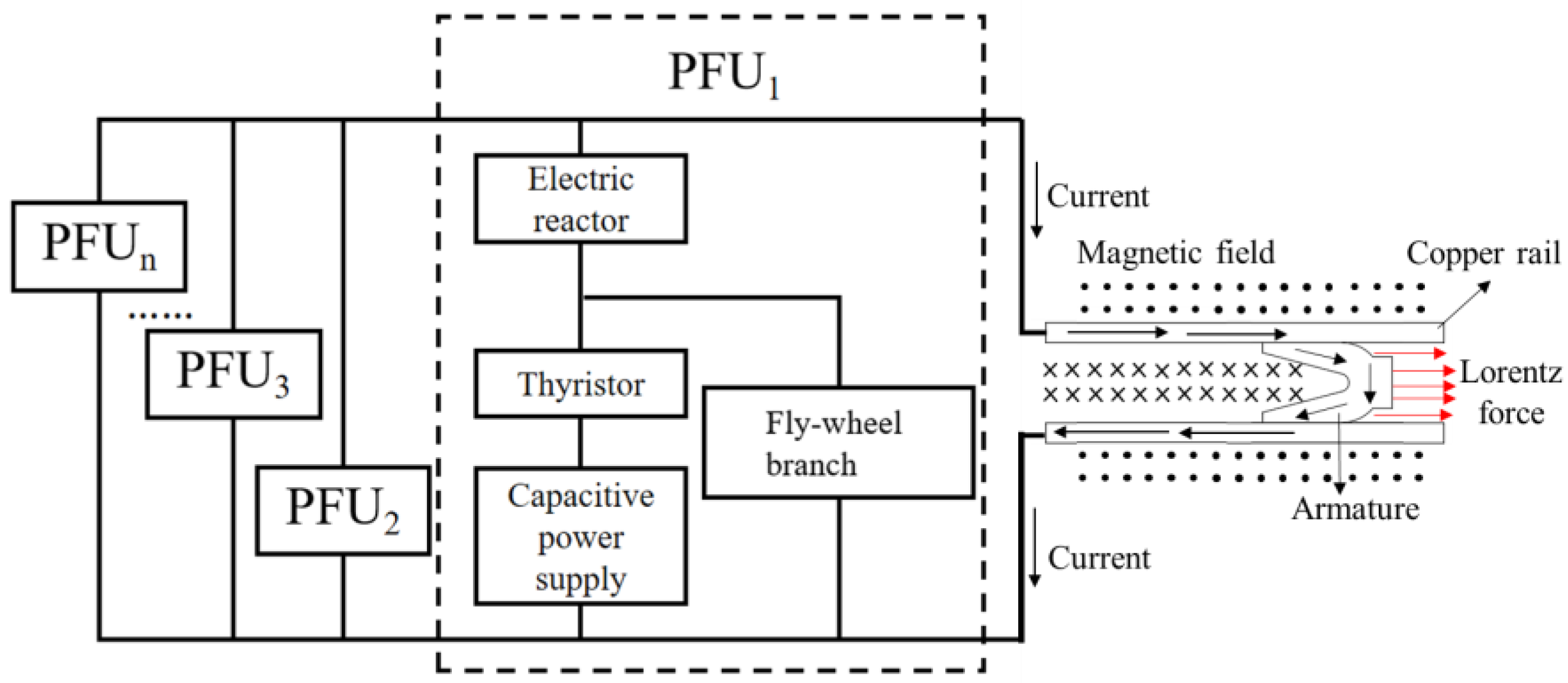
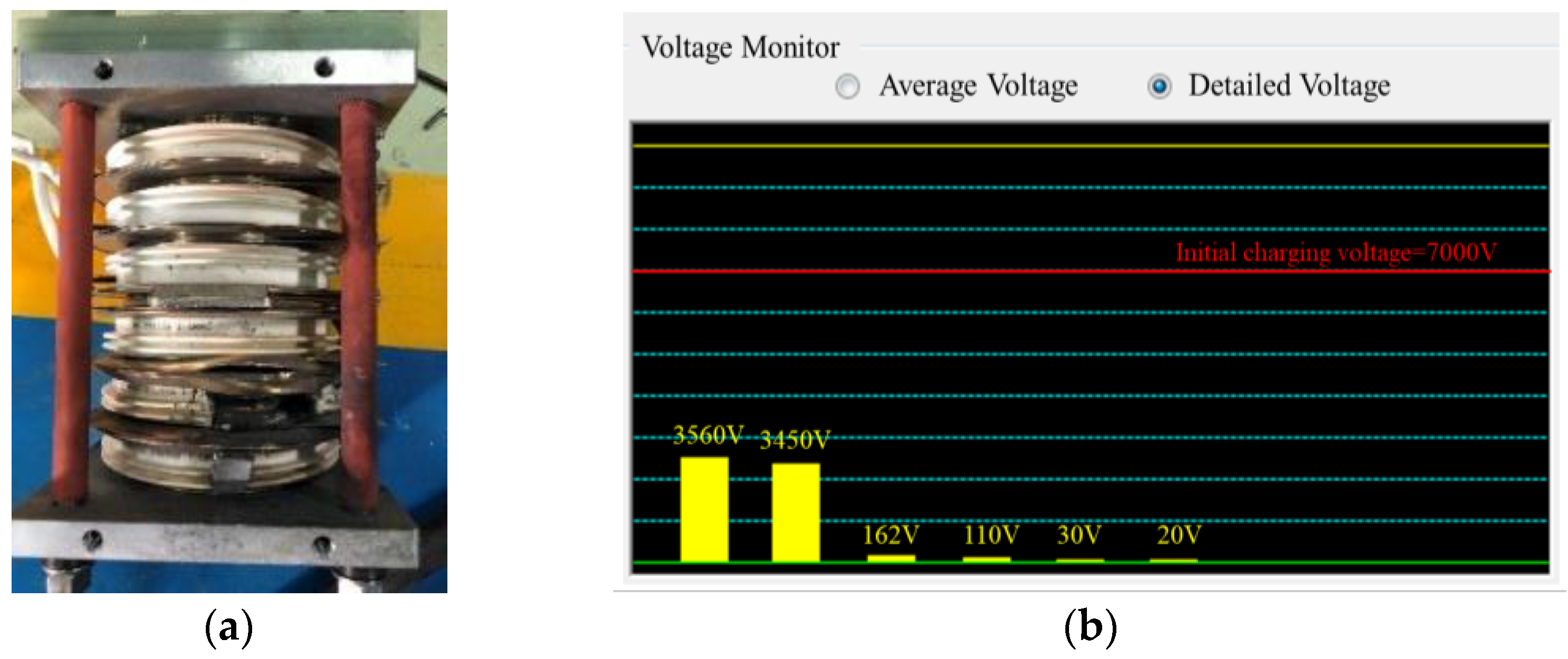

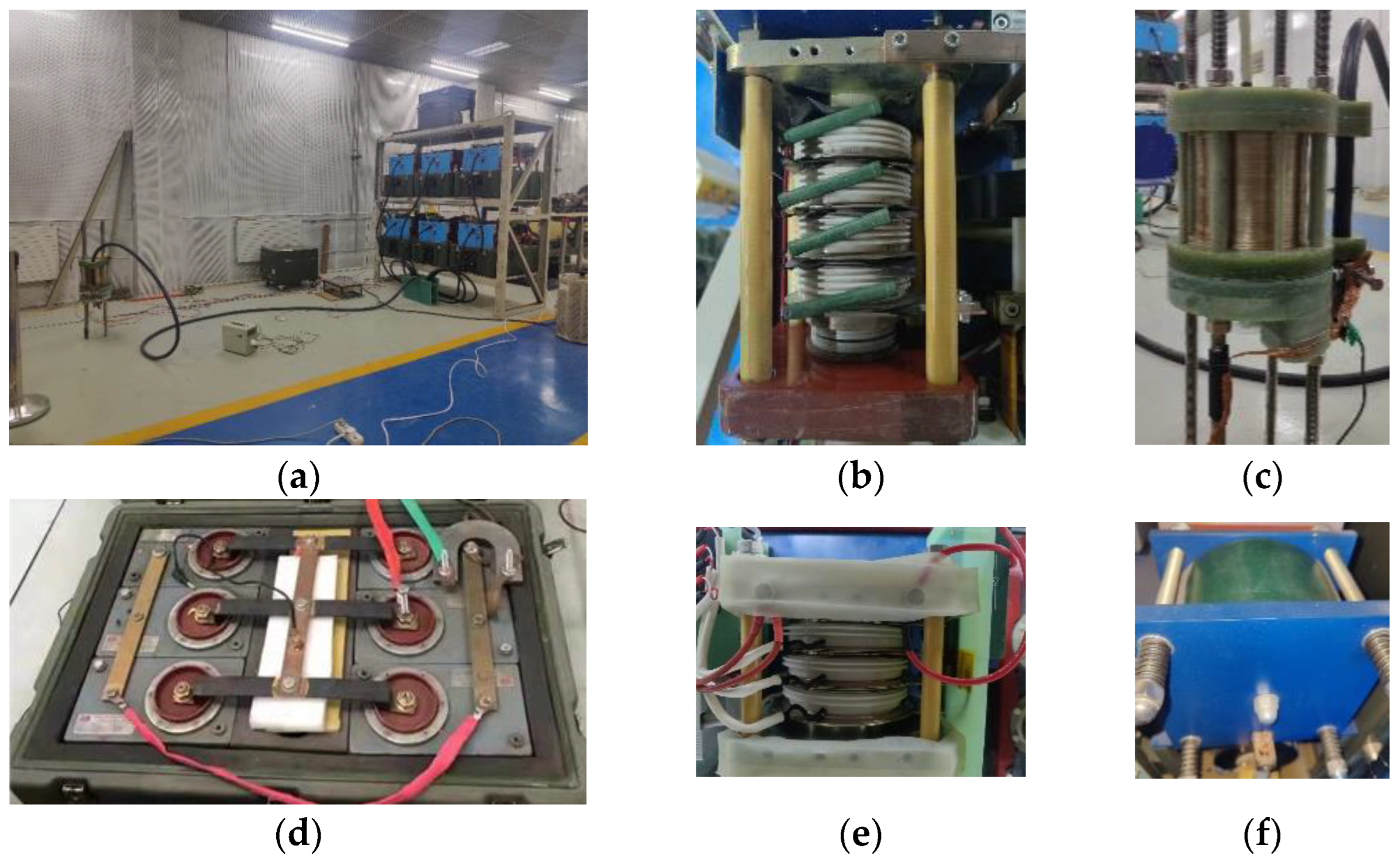
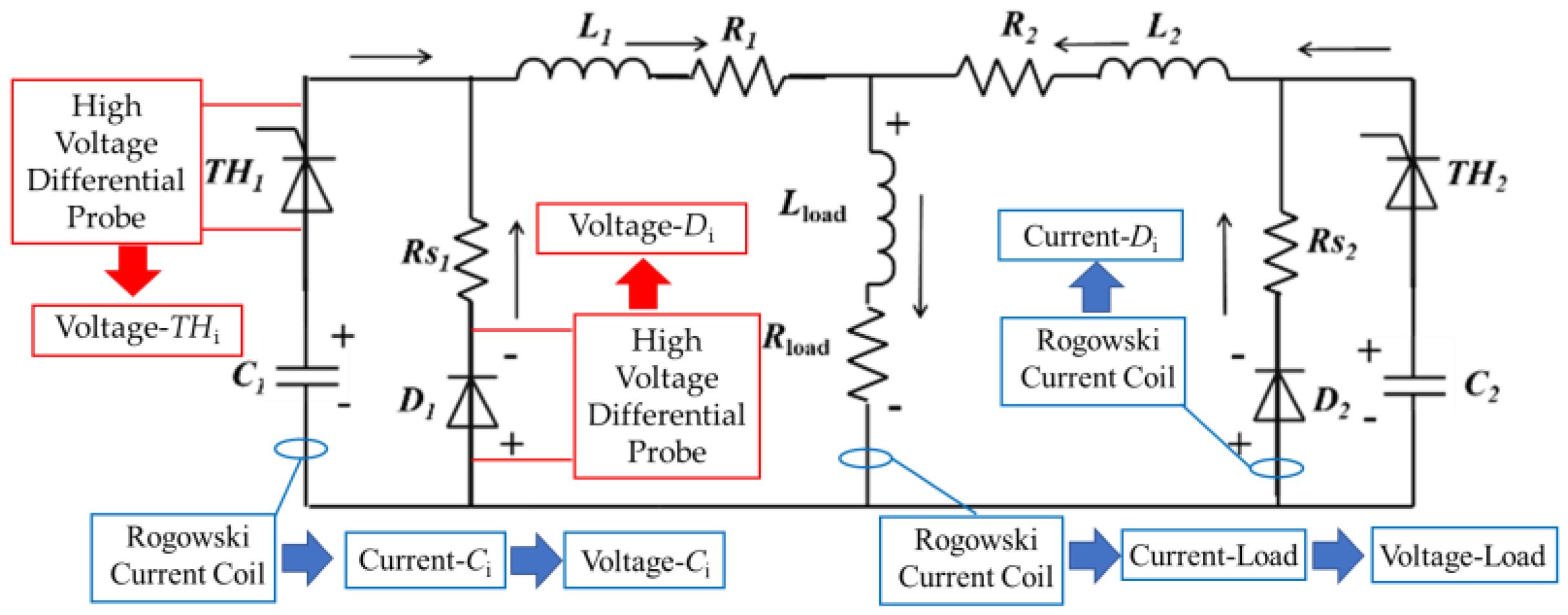

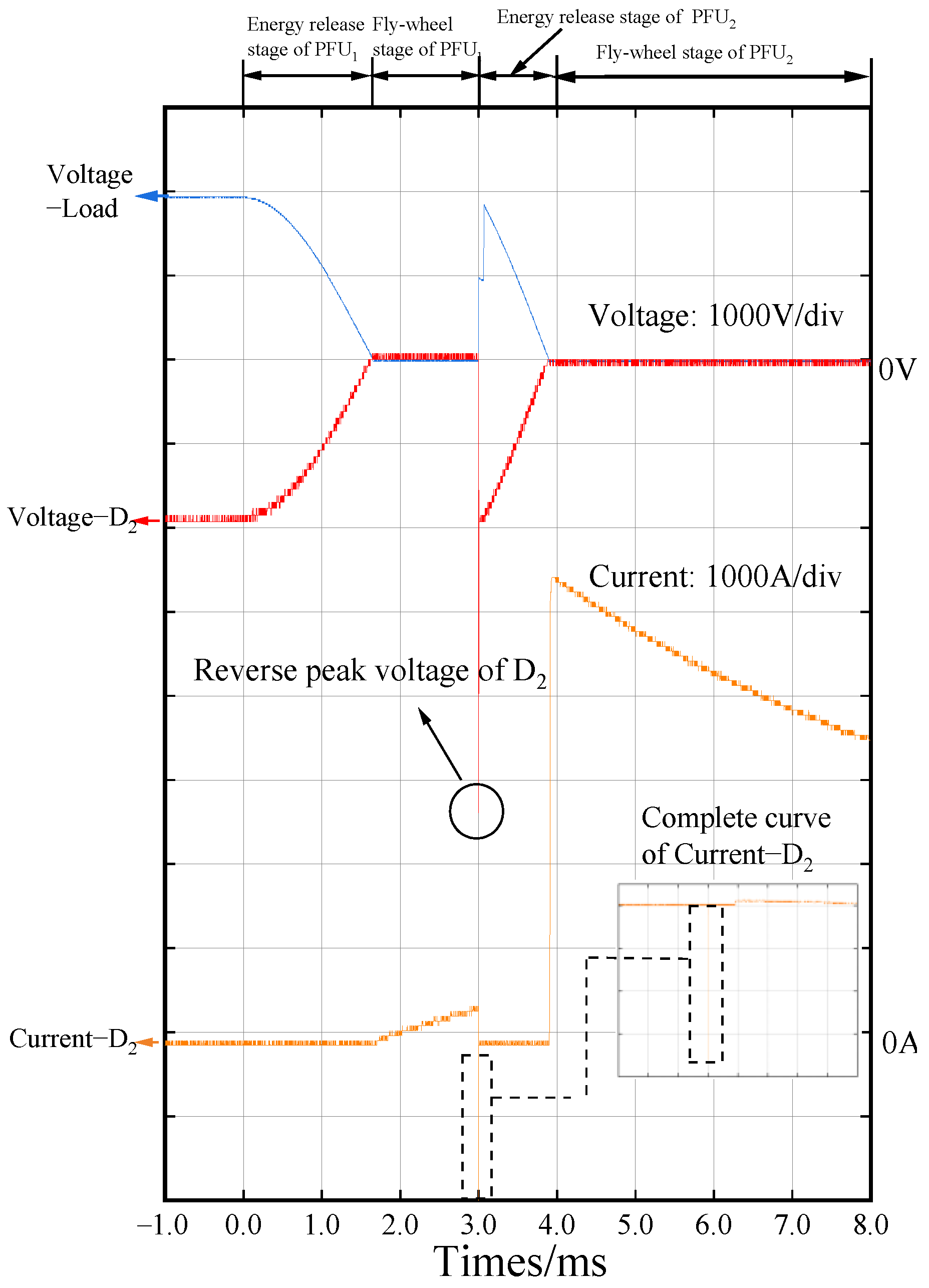
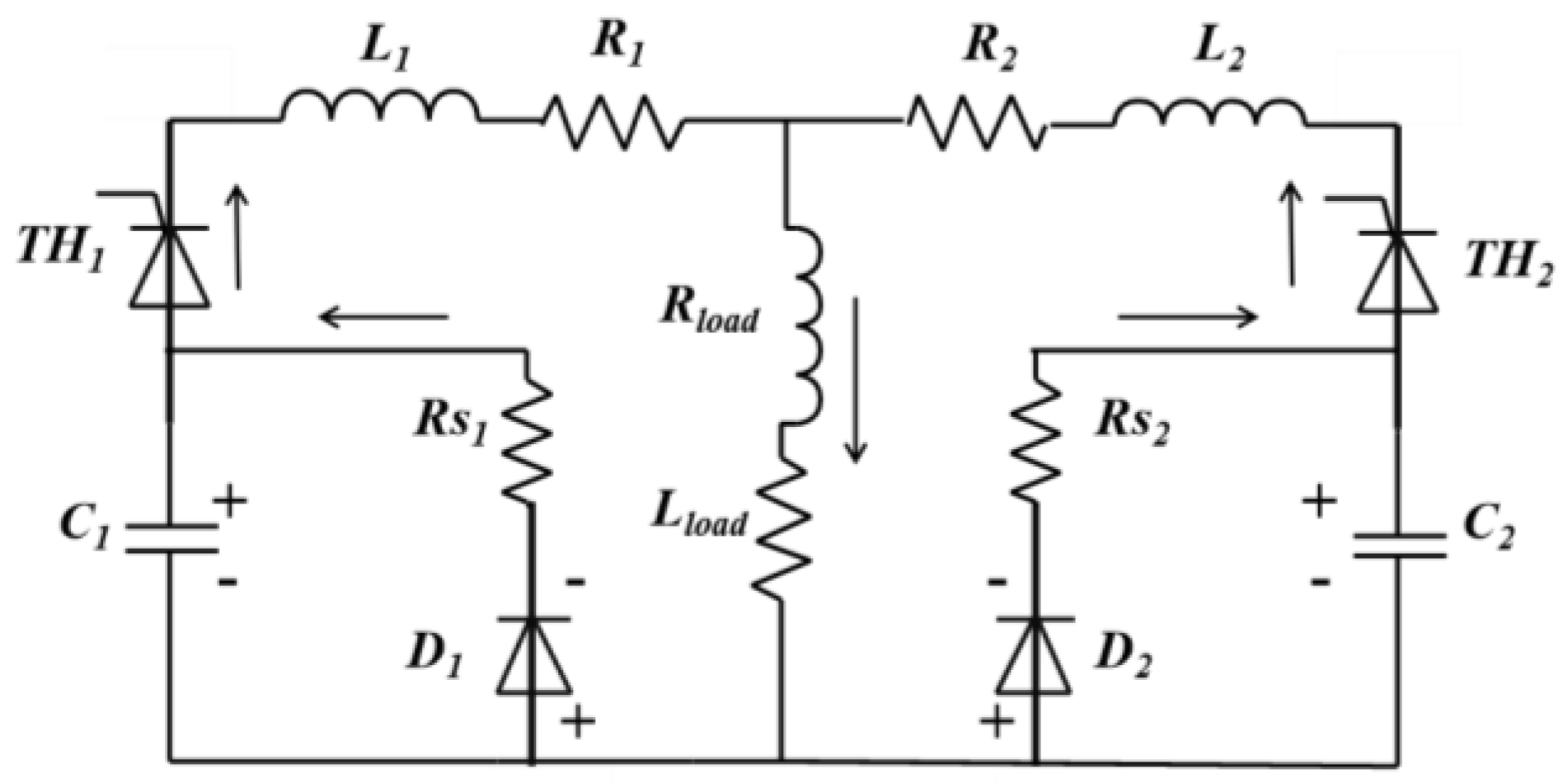



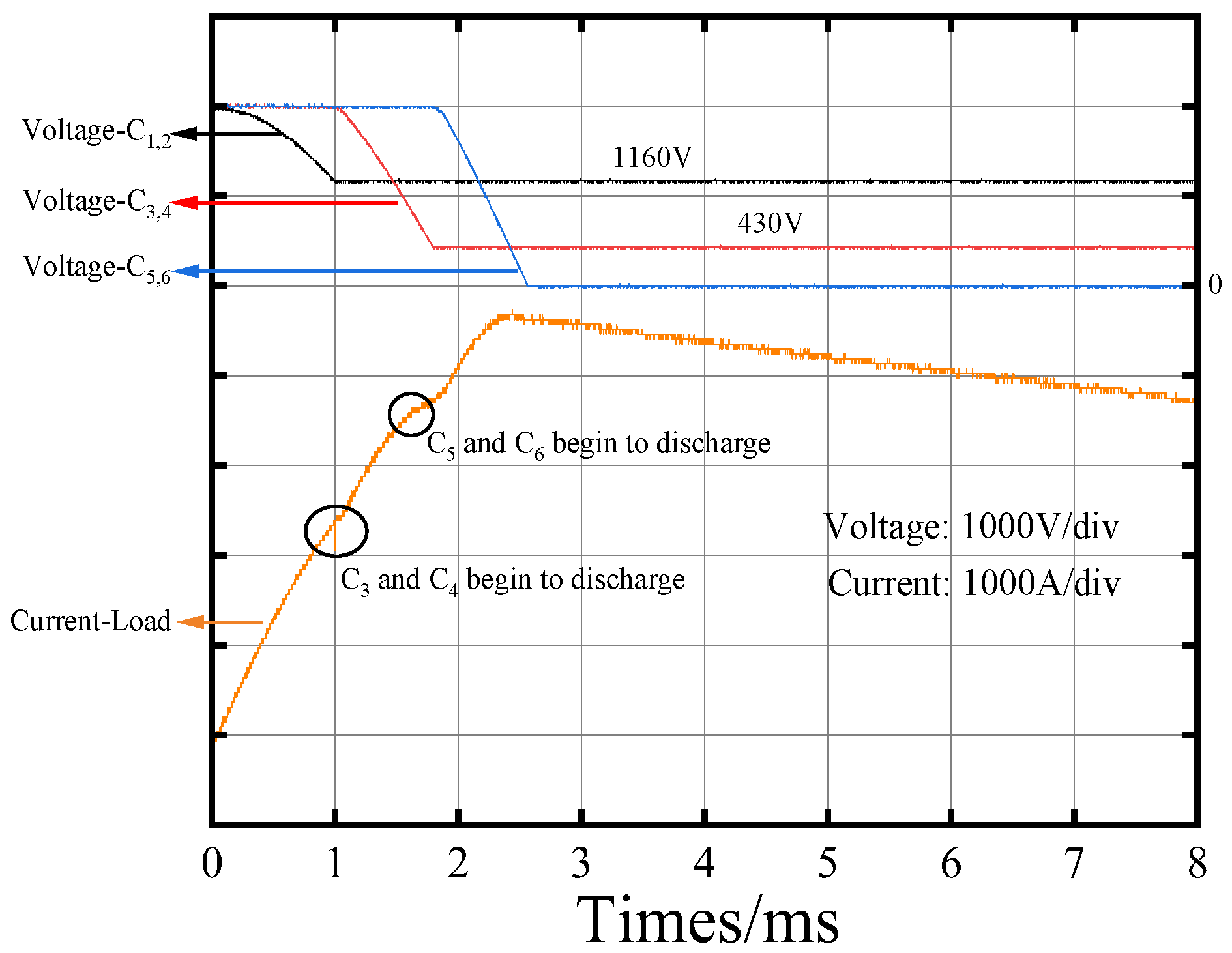



| Symbol | Meaning | Quantity |
|---|---|---|
| Rload | Load resistance | 17 mΩ |
| Lload | Load inductance | 530 uH |
| Ri | Resistance of the current wave modulator | 2 mΩ |
| Li | Inductance of the current wave modulator | 20 uH |
| Ci | Capacitance | 2 mF |
| Rsi | Fly-wheel resistance | 2 mΩ |
| u0 | Initial charging voltage of PFU | 2000 V |
| Symbol | Charging Voltage | Trigger Sequence in Tight Trigger Experiment | Trigger Sequence in Loose Trigger Experiment |
|---|---|---|---|
| PFU1 | 2000 V | 0 ms | 0 ms |
| PFU2 | 2000 V | 0 ms | 0 ms |
| PFU3 | 2000 V | 1 ms | 3 ms |
| PFU4 | 2000 V | 1 ms | 3 ms |
| PFU5 | 2000 V | 1.8 ms | 5 ms |
| PFU6 | 2000 V | 1.8 ms | 5 ms |
Disclaimer/Publisher’s Note: The statements, opinions and data contained in all publications are solely those of the individual author(s) and contributor(s) and not of MDPI and/or the editor(s). MDPI and/or the editor(s) disclaim responsibility for any injury to people or property resulting from any ideas, methods, instructions or products referred to in the content. |
© 2023 by the authors. Licensee MDPI, Basel, Switzerland. This article is an open access article distributed under the terms and conditions of the Creative Commons Attribution (CC BY) license (https://creativecommons.org/licenses/by/4.0/).
Share and Cite
Cao, G.; Xiang, H.; Qiao, Z.; Liang, C.; Yuan, X. Fault Mechanism and Improvement in the Augmented Railgun Excitation Circuit. Electronics 2023, 12, 4607. https://doi.org/10.3390/electronics12224607
Cao G, Xiang H, Qiao Z, Liang C, Yuan X. Fault Mechanism and Improvement in the Augmented Railgun Excitation Circuit. Electronics. 2023; 12(22):4607. https://doi.org/10.3390/electronics12224607
Chicago/Turabian StyleCao, Genrong, Hongjun Xiang, Zhiming Qiao, Chunyan Liang, and Xichao Yuan. 2023. "Fault Mechanism and Improvement in the Augmented Railgun Excitation Circuit" Electronics 12, no. 22: 4607. https://doi.org/10.3390/electronics12224607





